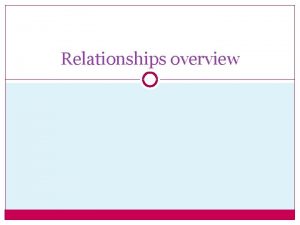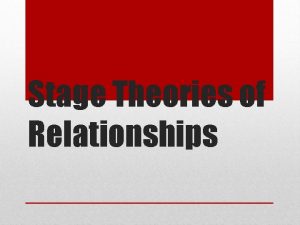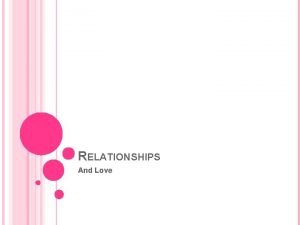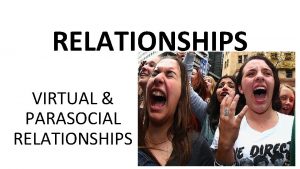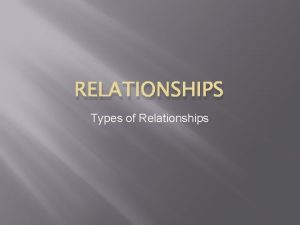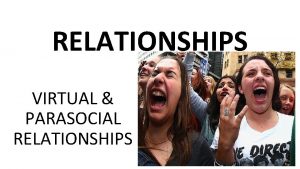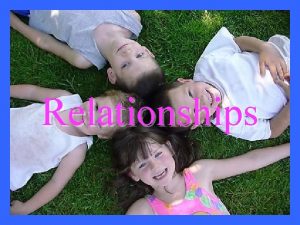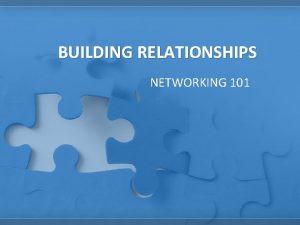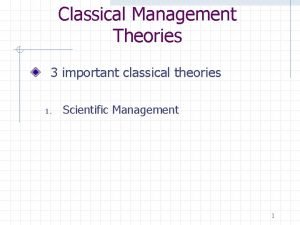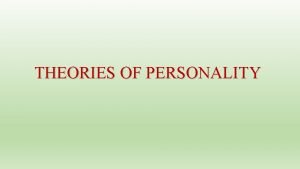RELATIONSHIPS THEORIES OF RELATIONSHIPS THEORIES OF RELATIONSHIPS The




















- Slides: 20

RELATIONSHIPS THEORIES OF RELATIONSHIPS

THEORIES OF RELATIONSHIPS • The next part of the Relationships module looks at how relationships develop, are maintained and how and why they might breakdown. • Booklet 3 (and this Power. Point) focus on what we term ‘Economic’ theories. • This basically means that relationships should be viewed in the same way as we would a business. We need to contemplate rewards, costs and investment(s).

THEORIES OF RELATIONSHIPS – SOCIAL EXCHANGE THEORY (SET) • Social Exchange Theory is an ‘economic theory’ - it takes the view that social relationships are run in a similar way to a business – people are haggling and negotiating in order to get the best deal. SET is based on the principles of operant conditioning which suggest we form and maintain relationships because they are rewarding – this means they are profitable because the rewards we receive from the relationship outweigh the costs incurred. This means that if the relationship stops being profitable because the costs outweigh the rewards the relationship will end.

THEORIES OF RELATIONSHIPS – SOCIAL EXCHANGE THEORY (SET) • Thibaut & Kelley (1959) proposed social exchange theory. It built upon theory that relationships form due to the rewards that we get from them. They argue that everybody is trying to maximise the REWARDS from a relationship and to minimise the COSTS. Therefore, a relationship is seen as a cost-benefit ratio. It’s the outcome of this cost-benefit ratio which determines our attraction to another. Only relationships which are seen as being PROFITABLE will be continued with.

THEORIES OF RELATIONSHIPS – SOCIAL EXCHANGE THEORY (SET) • SET suggests relationships are run like a balance sheet - partners are always trying to maximise their rewards and limit their costs. Satisfaction depends on the ‘outcome’ - the balance between rewards and costs - a successful relationship is a profitable one because the rewards outweigh costs, although a state of ‘loss’ will occur if the costs start to outweigh the rewards. • There are two ways to work out whether a relationship is profitable and thus worthy of continuing with. We consider the COMPARISON LEVEL (CL) and the COMPARISON LEVEL OF ALTERNATIVES (CLalt).

THEORIES OF RELATIONSHIPS – SOCIAL EXCHANGE THEORY (SET) • COMPARISON LEVEL (CL) - the amount of reward you feel you should receive. Your worth. Reflects social norms and takes into accounts previous relationships. • COMPARISON LEVEL OF ALTERNATIVES (CLalt) - refers to what you feel you could gain from being in a relationship with someone else. The idea that ‘the grass is always greener’. If CLalt is low you will stay in a relationship.

STARTER – 10 mins NO BOOKLETS!!!! • Recap (in pairs) what you can remember about the Social Exchange Theory of relationships (5 mins) • Try and use as many key words as possible (and define/explain these) • Try and apply it to both relationship maintenance and breakdown. • Swap with another pair and compare their answer with yours. What did they include that you didn’t and vice versa?

THEORIES OF RELATIONSHIPS – SOCIAL EXCHANGE THEORY (SET)

EVALUATING SOCIAL EXCHANGE THEORY (SET) Practical application for the stages of relationship development As SET is a ‘stage model’ it has practical, everyday application. For instance you can ‘plot’ your relationship against it, use it’s idea of costs and rewards to assess if you are in ‘profit’ or not and can even be used by a counsellor /therapist to identify problems in relationships which aren’t working. Many unsuccessful relationships (in therapy) highlight a lack of positive behavioural exchanges. Inappropriate reliance on economic metaphor Assuming all relationships work the same and applying this ‘business-like’ metaphor to them is overly simplistic. More likely is that work (colleague/colleague or employer/employee) relationships do operate according to these principles but romantic relationships probably don’t!

EVALUATING SOCIAL EXCHANGE THEORY (SET) We don’t really count the costs and rewards We don’t go around counting up the rewards and costs, we just get on with it. Also there is confusion over what exactly a reward or cost is. They’re highly subjective. This makes it difficult to weigh up ‘profit’. Argyle states we only start to count the cost when the relationship is already in trouble.

EVALUATING SOCIAL EXCHANGE THEORY (SET) Culturally relative SET assumes that we are happy if a relationship is in ‘profit’, (individualistic ideal), so SET doesn’t consider non-western, collectivist cultures where the emphasis is on equality, sharing of resources and fairness or even (Islamic culture) woman (over) benefitting the men.

EVALUATING SOCIAL EXCHANGE THEORY (SET) Pessimistic view of human nature as it ignores EQUITY Even within western culture its quite a negative point of view to consider we only form and maintain a relationship based on what we can get out of it. Surely some people like giving and just want to make their partner happy? • Hatfield (1979) questioned newlyweds(53 couples) and found…. that they were more satisfied with their relationship if they felt the relationship was equitable rather than being over or under benefitted. (Thus challenging SET)

SOCIAL EXCHANGE THEORY (SET) Complete the SET tasks on p. 5 and p. 6 of your booklets

EQUITY THEORY • Equity theory has the central assumption that people strive to achieve fairness in their relationships and feel distressed if they perceive unfairness. Any kind of inequity has the potential to create distress. People who give a great deal in a relationship and get little in return would perceive inequity, but the same is true of those who receive a great deal and give little in return. The greater the perceived inequity, the greater the dissatisfaction and the greater the distress.

EVALUATION OF EQUITY THEORY • Supporting research evidence such as Hatfield (1979) and Van Yperen and Buunk (1990). • Most of this research comes from real life accounts made by people in a relationship. What might some positives and negatives be of this kind of method (think reliability and validity)? This may be prone to social desirability bias as not only is it self report but it is asking about potentially sensitive issues (i. e. how good/bad is your relationship) and so people may not be entirely truthful when answering, thus leading to a lack of validity (accuracy/truthfulness)

EVALUATION OF EQUITY THEORY Moghaddam (1998) suggests that such 'economic' theories only apply to Western relationships, and even then only to certain shortterm relationships. One group of people who fit this are Western students. They are typically very mobile and experience many shortterm romantic relationships. When there is little time to develop longterm commitment, it makes sense to be more concerned with give and take. Long-term relationships within other population groups are more likely to value security than personal profit.

EVALUATION OF EQUITY THEORY Men and women might judge the equity of a relationship differently. Steil and Weltman (1991) found that among married working couples, husbands who earned more than their wives rated their own careers as the most important, and their wives tended to agree. In couples where the woman's income exceeded the man's, neither partner rated their career as more important.

EVALUATION OF EQUITY THEORY Type of relationship. The type of relationships researched can also be criticised for focusing on heterosexual relationships and not gay or lesbian relationships. Even in cohabiting or dating couples, there can be differences in the perception of profit and loss and the relationships economics. The relationships used are often not representative of the general population, particularly in Western cultures where homosexual relationships are widely accepted

Rusbult’s Investment Theory • Rusbult et al. ’s (2011) model of commitment in a romantic relationship builds upon the Social Exchange Theory. • Satisfaction and Comparison with Alternatives are considered and contribute to how much a partner feels a relationship is worthwhile for them when comparing other possible relationships and their investment against the rewards offered by the pairing. • The third factor is an addition to the SET, investment size, which explains why relationships do not all breakdown when the CL or CLalt are low. • Investment in relationships can be measured as a combination of intrinsic and extrinsic investments which have been made over the course of the relationship. Intrinsic investments are those which have been added by a single partner such as money towards a date or a gift, time spent with the person and any selfdisclosures which have been made. Extrinsic investments are those which have been created or developed over the course of the relationship which are shared by both partners, such as large purchases (a house or car) or even children.

Rusbult’s Investment Theory Le and Agnew’s (2003) conducted a meta-analysis of studies relating to similar investment models found that satisfaction, comparison with alternatives and investment were all strong indicators of commitment to a relationship. This importance was the same across cultures, genders, and also applied to homosexual relationships. Many of the studies relating to investment in relationship rely on self-report technique. Whilst this would be perceived as a less reliable and overly-subjective method in other areas, when looking at the amount an individual feels they are committed to a relationship, their own opinion and the value that they place on behaviours and attributes is more relevant than objective observations. Investment models tend to give correlational data rather than causal, it may be that a commitment established at an earlier stage leads inevitably to the partner viewing comparisons more favourably and investing more into the relationship.
 Các châu lục và đại dương trên thế giới
Các châu lục và đại dương trên thế giới ưu thế lai là gì
ưu thế lai là gì độ dài liên kết
độ dài liên kết Thẻ vin
Thẻ vin Môn thể thao bắt đầu bằng chữ f
Môn thể thao bắt đầu bằng chữ f Cái miệng nó xinh thế chỉ nói điều hay thôi
Cái miệng nó xinh thế chỉ nói điều hay thôi Hát kết hợp bộ gõ cơ thể
Hát kết hợp bộ gõ cơ thể Từ ngữ thể hiện lòng nhân hậu
Từ ngữ thể hiện lòng nhân hậu Trời xanh đây là của chúng ta thể thơ
Trời xanh đây là của chúng ta thể thơ Tư thế ngồi viết
Tư thế ngồi viết Ví dụ về giọng cùng tên
Ví dụ về giọng cùng tên Voi kéo gỗ như thế nào
Voi kéo gỗ như thế nào Thể thơ truyền thống
Thể thơ truyền thống Khi nào hổ mẹ dạy hổ con săn mồi
Khi nào hổ mẹ dạy hổ con săn mồi Thế nào là hệ số cao nhất
Thế nào là hệ số cao nhất Diễn thế sinh thái là
Diễn thế sinh thái là đại từ thay thế
đại từ thay thế Frameset trong html5
Frameset trong html5 Vẽ hình chiếu vuông góc của vật thể sau
Vẽ hình chiếu vuông góc của vật thể sau Thế nào là mạng điện lắp đặt kiểu nổi
Thế nào là mạng điện lắp đặt kiểu nổi Mật thư tọa độ 5x5
Mật thư tọa độ 5x5




























